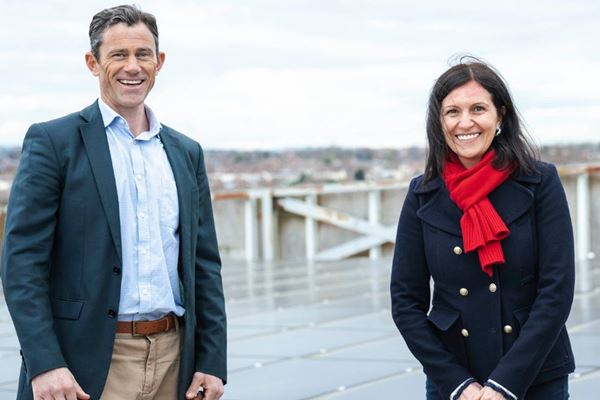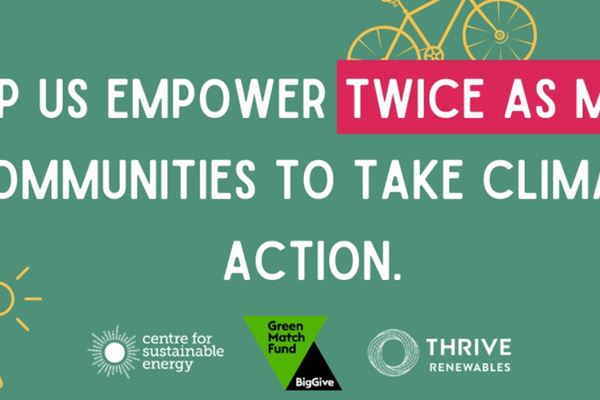"Your kettle, your washing machine, your cooker, your heating, your plug-in electric vehicle - the whole lot of them will get their juice cleanly and without guilt from the breezes that blow around these islands". Boris Johnson, Prime Minister
It is positive to hear a commitment to the clean energy transition coming from government and recognising offshore wind power as a vital part of this with immense potential. The government plans to increase its offshore capacity target from 30 to 40GW and aim for every home to be powered by offshore wind in the next decade.
However positive these targets are, they are high level and lack detail. The UK cannot reach net zero solely with offshore wind, the proposed 40GW, represents only 21% of the low carbon electricity generation capacity required by 2050 according to the Committee on Climate Change. Whole-system changes to the UK’s electricity system are essential; how it’s distributed, how we balance supply and demand, how and when we use electricity. And we need policy detail from government on the frameworks for home owners, businesses and industry to deliver the transition over the next decade.
How do we adapt our electricity system to work for net zero?
More renewables
According to the UK Energy Research Centre, as we decarbonise not just the power system but heating and transport as well, electricity demand is set to double. The government’s target of 40GW of new offshore capacity is geared towards our current levels of electricity use. However, with drivers switching to electric vehicles, electrifying the railways and as we cease to heat our homes with fossil fuels, powering all the UK’s homes alone could require 67GW of offshore capacity, according to one estimate. On top of this, homes only account for a third of our electricity demand, the rest goes to offices, commerce and industry.
We need more renewables on the grid. And as with the legacy fossil fuelled system, importantly we need variety - of technologies, sizes, and ownership.
It’s well documented that onshore wind and solar are now the cheapest forms of new electricity generation, and in many cases, cheaper than running existing coal-fired powerplants. Industry associations have recommended that the UK install 5.5GW of onshore renewables, including wind, solar and hydro, each year between now and 2035 if we are to meet net zero, 150% more than we are currently building.
A diverse electricity system creates resilience. By using a variety of different renewable technologies, we circumvent the limitations of each. Hydro, and geothermal, such as United Downs in Cornwall which is currently under development, can provide baseload electricity. While wind and solar energy is variable, it can be combined with storage technology to shift excess electricity to be used when demand is high.
As well as using diverse technologies, decentralised electricity systems are more resilient to the effects of climate change. For example, this could mean installing rooftop solar panels, which can provide off-grid power to homes, or creating larger district heating networks that generate heat for those living in an area from a local, renewable source.
Storage & flexibility
Storage is an essential part of a diverse and decentralised electricity system dominated by renewables. To manage the variability of renewables like wind and solar and the complex relationship between demand and supply we need to provide both short and long-term flexibility to the electricity grid.
Short-term flexibility
Balancing the electricity grid is incredibly complex and vital to keeping the lights on and the country moving. Electricity is transported the length of the country, levels of generation must be managed so they are perfectly balanced with levels being used, and properties like voltage and frequency are minutely regulated across the whole network to ensure power generated at scale in industrial power stations can be used by domestic appliances plugged into wall sockets.
To date, many of these balancing services have been provided by thermal power stations, coal, gas, biomass. But as we move away from polluting fossil fuels and towards decarbonisation, we must find new, clean ways to carry out these services. One of the technologies that’s expected to provide an increasing amount of balancing services is grid-scale batteries. One stabilisation function offered by batteries (and other electricity storage options) is to provide reserve at times when demand peaks or troughs. Batteries can also absorb and generate reactive power, which can then be deployed to push voltage up or down when it starts to creep too far from the target needed to safely move electricity around the grid.
The role of batteries in balancing power grids and saving surplus energy represents a concrete means of improving energy efficiency and integrating more renewable energy sources into electricity systems. Batteries will also enhance energy security and create a well-functioning internal market with lower prices for consumers. Grid-scale batteries can also be co-located on the sites of existing renewable energy projects such as wind and solar farms. This allows it to use the existing grid infrastructure and reduces costs.
Long-term flexibility
A major challenge with the current battery storage solutions, such as Lithium Ion, is it works best in the short-term, providing minute to minute balancing services for the grid. The quantity of megawatt hours required to compensate for variability is very large. Peak electricity demand is routinely double that of the overnight load on the UK’s electricity system.
Periods of low variable generation are highly likely with an electricity system dominated by renewable technologies such as wind and solar. To provide flexibility over longer periods we must look for other energy storage solutions.
One such solution is pumped storage hydropower, which uses two reservoirs at different elevations connected by a pipe which contains a turbine. During periods of high renewable generation, excess electricity can be used to pump the water from the lower reservoir to the higher reservoir. And when renewable generation is low, the water will flow down from the upper reservoir through the pipe and the turbine, generating electricity. With its ability to both store and generate large amounts of energy over long periods of time, it can play a key role in compensating for variable generation from a renewable dominated grid.
The need for long-term storage solutions has stimulated much innovation and new technologies are continuously emerging. Compressed Air Energy Storage (CAES) compresses and stores ambient air or another gas under pressure in an underground cavern or container when renewable electricity is abundant. When electricity is required, the pressurised air is heated and expanded in an expansion turbine driving a generator for power production.
Gravitricity, a UK start-up, uses gravity, raising and lowering a heavy weight down a deep hole such as a disused mine shaft, to store and release energy. In periods of high renewable supply, they use abundant clean electricity to raise the weights up. And during periods of high demand the weights are lowered, turning a turbine and generating electricity.
Other emerging storage technologies include chemical storage such as green hydrogen. Excess renewable generation can be used to power electrolysis, splitting water molecules into hydrogen and oxygen molecules and storing the hydrogen for later use. Whilst a lot of challenges persist for the wide use of hydrogen in the energy system, its potential compatibility with existing fossil fuel infrastructure means we are likely to see a lot of development in this space.
People
People are part of the electricity system. We are the consumers of electricity, dictating supply and demand. We need to ensure the national electricity system works for people and the planet. One essential part of this is energy efficiency, supporting people to use less wherever possible.
The electricity system of the future needs to be smart and integrated seamlessly into our daily lives. Currently supply is a slave to demand and this relationship needs to be more balanced. The better we can match daily demand to renewable supply, the less infrastructure we’ll need and the cleaner the system will be. We need to empower consumers to use electricity when its abundant, managing demand and in turn helping to balance the grid. To an extent this can be carried out with simple behaviour changes, running your washing machine, heating water or charging your electric vehicle on particularly windy days and switching devices off during peak times. Initiatives to encourage this behaviour have begun to emerge. Octopus Energy launched its first time of use tariff in 2018, allowing customers to pay less for electricity when used out of peak times. In April this year, electricity prices dropped so low that customers were paid to use electricity. But it is unfeasible to put the weight of responsibility for the shift to low carbon electricity solely on the shoulders of individuals. With the advancement of smart grid technology, smart meters and internet enabled devices, our washing machines, freezers, hot water tanks and EVs should know when the most sustainable time to use electricity is, as well as using less.
People need to not only be empowered to use electricity but to also play a role in generating it. Community energy puts people at the heart of the electricity system. It brings them together to take democratic climate action by understanding, generating, owning, using, and saving energy. Community energy provides clear accountability and participatory governance within the energy system, which is empowering, transparent and equitable. It accelerates a just transition to a zero-carbon energy system, making communities more prosperous and resilient. Successful community energy can also help to underpin the more rapid rollout of a decentralised energy supply system by giving local people a stake in the outcome.
As more renewables have come onstream over the last decade, the UK has been moving towards a decentralised system, where energy is generated and used locally. Decentralising energy can reduce transmission losses, making the system more efficient. Security of supply is increased nationally too, especially against the impacts of climate change. There can be economic benefits also. Long term, decentralised energy can offer more competitive prices than traditional energy. Pinning our energy transition hopes solely on huge, remote offshore wind farms seems to be under utilising this progress.
The Energy White Paper
There is no doubt that the UK has taken some big steps in decarbonising the energy system. The amount of electricity generated by renewables has increased from just 6.5% in 2010 to over a third today. But we still have an immense amount work to do, and to do it we need policy and structure. We need a progressive Energy White Paper which clearly sets out a trajectory which industry and individuals can deliver.
The journey to net zero is complex with many possible pathways. We don’t have all of the answers yet, but as we move in the right direction, more solutions will develop. We must evolve our generation, consumption and all the interlinking systems that keep the lights on; this includes our own behaviour. But for us to move forward together, with a harmonised focus and direction, the Energy White Paper must provide detail. It must look at the electricity system as a whole and set us on the right path. We need a road map that recognises the complexity of the challenge we face.



